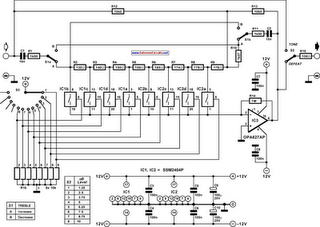Home » Circuits
Treble Tone Control
The treble control works in a similar manner as the bass control elsewhere in this site, but contains several modifications, of course. One of these is the series network C1-C2– R1– R1 1. The d.c. operating point of IC3 is set with resistors R12 and R13. To ensure that these resistors do not (adversely) affect the control characteristics, they are coupled to the junction of R9 and R1 0. In this way they only affect the low-frequency noise and the load of the opamp. Their value of 10 kΩ is a reasonable compromise. The functions of switches S1– S3 are identical to those of their counterparts in the bass tone control; their influence is seen clearly in the characteristics.Circuit diagram:

Good symmetry between the left-hand and right-hand channels is obtained by the use of 1% versions of R1– R1 3 and C1, C2. The value of resistors R2– R1 0 is purposely different from that of their counterparts in the bass tone control. In the present circuit, the control range starts above 20 kHz. To make sure that a control range of 1 0 dB is available at 20 kHz, the nominal amplification is 3.5 (11 dB ). The control circuit draws a current of about ±10 mA.
